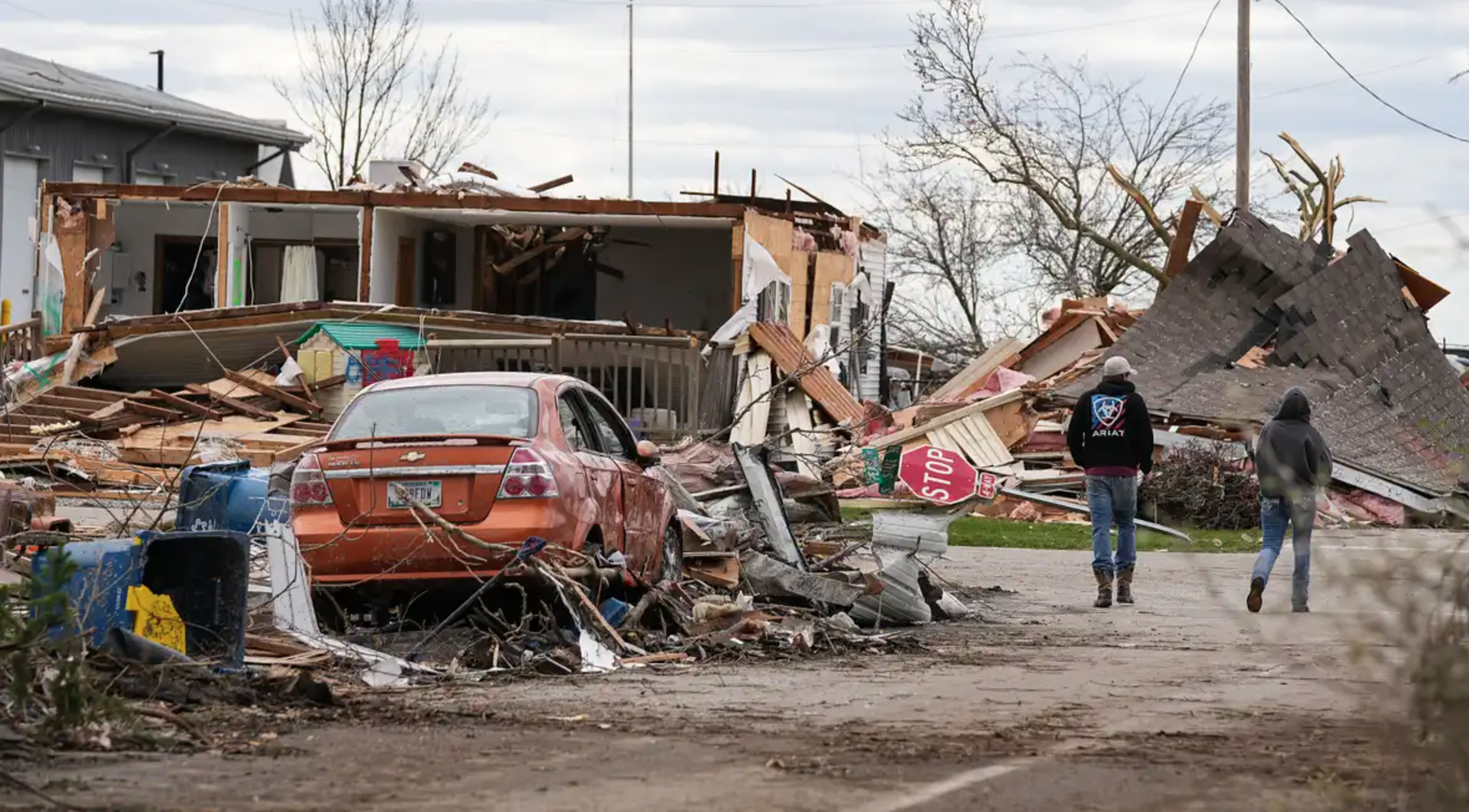Homes in Whiteland, Indiana face the aftermath of a tornado that ripped through the town on April 1. Photo courtesy of Grace Hollars of IndyStar.
TYLER ELLIS | STAFF REPORTER | teellis@butler.edu
Indiana’s tornado season is in full swing, and newcomers to the Midwest are finally able to understand why Indianapolis tests its tornado sirens every Friday. Indiana is in the “tornado alley,” a group of states that is considered to be at a statistically higher risk for tornadoes in the spring and summer.
Although typically concentrated in states such as Oklahoma and Texas, the tornado alley has begun to shift eastward, affecting Midwestern states such as Indiana more than usual. Most tornadoes hit Indiana between April and June, impacting a significant portion of Butler’s spring semester. The frequency of these storms make it necessary for students to have a plan for severe weather on campus.
Nikki Foster, a sophomore English and race, gender and sexuality studies double major and a resident assistant in Residential College, was tasked with helping her residents shelter-in-place during the tornado watch on March 31.
“I sent a text message, but not everyone looks at their texts, so I started banging on people’s doors, saying, ‘Go down to the basement,’” Foster said. “[The tornado sirens] stopped blaring, and everyone kind of started walking back, but we weren’t technically supposed to go back quite yet.”
Despite trying to relay information to her residents, Foster experienced some pushback while trying to give directions, especially when students were refusing to stay in the basement during the tornado watch. Foster’s advice to Butler students is to listen to those with authority and understand the potential severity of severe weather.
“Tornadoes are very serious, and I think a lot of people don’t really understand that if they don’t come from areas that have experienced tornadoes frequently,” Foster said. “We genuinely had people try to go outside when the tornado sirens went off. I think that they think it’s cool, and they don’t really understand how deadly tornadoes are.”
Foster also acknowledged that Butler’s current severe weather system could be improved upon, particularly in regard to the accessibility of sirens. Some students, Foster said, could have missed the alarm while in their room or wearing headphones. Additionally, auditory alarms may not be accessible for disabled students.
“Our fire alarms flash, so I think a flashing [tornado alarm] could be nice too,” Foster said. “Especially because we do have deaf students or people who are hard of hearing, and they might not be able to hear everything going around them.”
Another concern of Butler students during tornado season is the well-being of their families and hometowns. Lily Miller, a senior youth and community development major, was with her family in Swayzee, Indiana when the tornado touched down.
“My dad was listening to a police scanner, and we were hearing about horrible damage on the other side of town, and I am from a town that has like 900 people — it’s probably like a couple square miles,” Miller said. “They did wellness checks on every single person on one street because the street was just destroyed.”
Although Miller’s house was spared, a few yards were the difference between safety and total destruction.
“There were trees that were decades old that were completely uprooted,” Miller said. “There were several houses that I know will have to be completely torn down and were just completely ruined.”
Miller said that parents of students in Swayzee were worried about the severe thunderstorms on April 5, eventually prompting administration to send students home early as a precaution. The severe thunderstorms that day also affected Butler, with some professors canceling class out of concern for the safety of commuter students.
Vesemir Johnson, a junior music education major, said that he hoped for a campus-wide weather delay or cancellation for students’ safety. Johnson was commuting home with friends from a convention in Muncie, Indiana when the tornado watch reached Indianapolis.
“For certain people with different types of mobility, it’s really hard to get around in weather like that,” Johnson said. “I know they have [assistance] for cold weather and ice — it’s something to consider if it’s not already happening.”
Johnson and his friends made it back to campus safely, but driving at night through the storm proved difficult as high winds and heavy precipitation made it difficult to navigate a previously familiar route.
“As we got close to campus, it was pouring so hard that the windshield wipers were doing nothing — we couldn’t see anything,” Johnson said. “There was a trash can that fell into the street and flash flooding down the road. It was really hard to get back to Butler, so we had to drive really slow to get through.”
While spring tornadoes can be seen as a reality of Midwestern life, they are also unpredictable and often life-threatening. Staying aware of campus resources, storm shelters, and weather alerts is key to being prepared and informed in case of an emergency.
Tornado tips
- Know the difference between a tornado watch and a tornado warning
- Have an emergency plan for pets and valuables
- Identify shelter-in-place locations and know how to access them
- Stay indoors, away from windows, and below ground
- Download weather apps
- Follow instructions from Dawg Alert



